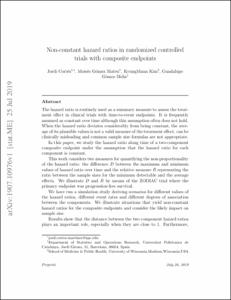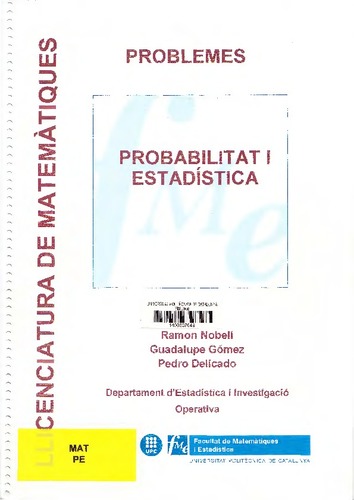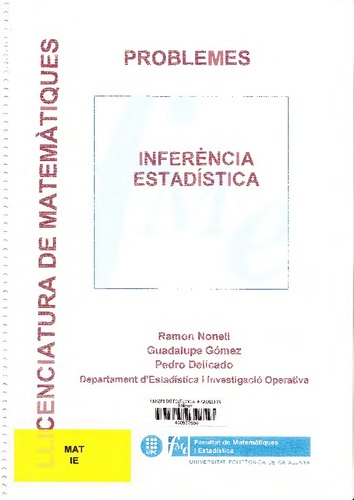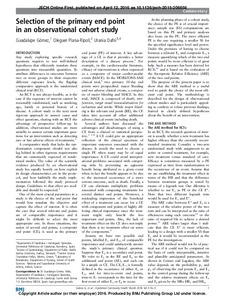Exploració per autor "Gómez Melis, Guadalupe"

Ara es mostren els items 58-77 de 90
-
Mesa redonda: La Estadística en la Investigación Médica

Abraira Santos, Víctor; Cadarso, Carmen; Gómez Melis, Guadalupe; Martín Andrés, Antonio; Pita, Salvador (Institut d'Estadística de Catalunya, 2001)
Abraira Santos, Víctor; Cadarso, Carmen; Gómez Melis, Guadalupe; Martín Andrés, Antonio; Pita, Salvador (Institut d'Estadística de Catalunya, 2001)
Article
Accés obertEste artículo es una transcripción de las conferencias dictadas en la mesa organizada en el 4º Congreso Galego de Estatistica y Investigación de Operacions que tuvo lugar en Santiago de Compostela en noviembre de 1999. Los ... -
Modeling the coronavirus disease 2019 incubation period: impact on quarantine policy

Pak, Daewoo; Langohr, Klaus; Ning, Jing; Cortés Martínez, Jordi; Gómez Melis, Guadalupe; Shen, Yu (Multidisciplinary Digital Publishing Institute (MDPI), 2020-09-21)
Pak, Daewoo; Langohr, Klaus; Ning, Jing; Cortés Martínez, Jordi; Gómez Melis, Guadalupe; Shen, Yu (Multidisciplinary Digital Publishing Institute (MDPI), 2020-09-21)
Article
Accés obertThe incubation period of coronavirus disease 2019 (COVID-19) is not always observed exactly due to uncertain onset times of infection and disease symptoms. In this paper, we demonstrate how to estimate the distribution of ... -
MSMpred: interactive modelling and prediction of individual evolution via multistate models

Garmendia Bergés, Leire; Cortés Martínez, Jordi; Gómez Melis, Guadalupe (Springer Nature, 2023-05-24)
Garmendia Bergés, Leire; Cortés Martínez, Jordi; Gómez Melis, Guadalupe (Springer Nature, 2023-05-24)
Article
Accés obertBackground: Modelling the course of a disease regarding severe events and identifying prognostic factors is of great clinical relevance. Multistate models (MSM) can be used to describe diseases or processes that change ... -
Multiple imputation approach for interval-censored time to HIV RNA viral rebound within a mixed effects Cox model

Alarcón Soto, Yovaninna; Langohr, Klaus; Fehér, C.; García Alcaide, Felipe; Gómez Melis, Guadalupe (2018-01-01)
Alarcón Soto, Yovaninna; Langohr, Klaus; Fehér, C.; García Alcaide, Felipe; Gómez Melis, Guadalupe (2018-01-01)
Article
Accés obertWe present a method to fit a mixed effects Cox model with interval-censored data. Our proposal is based on a multiple imputation approach that uses the truncated Weibull distribution to replace the interval-censored data ... -
Non-constant hazard ratios in randomized controlled trials with composite endpoints

Cortés Martínez, Jordi; Gómez Mateu, Moisès; Kim, Kyungman; Gómez Melis, Guadalupe (2019-07-25)
Cortés Martínez, Jordi; Gómez Mateu, Moisès; Kim, Kyungman; Gómez Melis, Guadalupe (2019-07-25)
Article
Accés obertThe hazard ratio is routinely used as a summary measure to assess the treatment effect in clinical trials with time-to-event endpoints. It is frequently assumed as constant over time although this assumption often does not ... -
Nonlinear transformation models: application to mortality of calves

López-Segovia, Lucas; Espinal Berenguer, Anna; Gómez Melis, Guadalupe (2010)
López-Segovia, Lucas; Espinal Berenguer, Anna; Gómez Melis, Guadalupe (2010)
Text en actes de congrés
Accés obertWe present. an appl ication of the proportional hazard-proportional hazard cure models to evalu ate the environmental and genetic factors that affect both mortality and survival up to weaning of beef calves. We usc the ... -
Probabilitat i Estadística - Problemes

Gómez Melis, Guadalupe; Delicado Useros, Pedro Francisco; Nonell, Ramon (Universitat Politècnica de Catalunya, 2001)
Gómez Melis, Guadalupe; Delicado Useros, Pedro Francisco; Nonell, Ramon (Universitat Politècnica de Catalunya, 2001)
Apunts
Accés obert -
Problemes d'Estadística Matemàtica 2

Gómez Melis, Guadalupe; Nonell, Ramon; Delicado Useros, Pedro Francisco (Universitat Politècnica de Catalunya, 2000)
Gómez Melis, Guadalupe; Nonell, Ramon; Delicado Useros, Pedro Francisco (Universitat Politècnica de Catalunya, 2000)
Apunts
Accés obert -
Problemes Inferència Estadística

Gómez Melis, Guadalupe; Nonell, Ramon; Delicado Useros, Pedro Francisco (Universitat Politècnica de Catalunya, 2001)
Gómez Melis, Guadalupe; Nonell, Ramon; Delicado Useros, Pedro Francisco (Universitat Politècnica de Catalunya, 2001)
Apunts
Accés obert -
Quantile estimation of the rejection distribution of food products integrating assessor values and interval-censored consumer data

Langohr, Klaus; Gómez Melis, Guadalupe; Hough, Guillermo (2013-12)
Langohr, Klaus; Gómez Melis, Guadalupe; Hough, Guillermo (2013-12)
Article
Accés restringit per política de l'editorialFitting parametric survival models with interval-censore d data is a common task in survival analysis and implemented in many statistical software pack ages. Here, we present a novel approach to fit such models if the ... -
Recommendations to choose the primary endpoint in cardiovascular clinical trials

Gómez Melis, Guadalupe; Gómez Mateu, Moisés; Dafni, Urania (2013)
Gómez Melis, Guadalupe; Gómez Mateu, Moisés; Dafni, Urania (2013)
Report de recerca
Accés obertBackground – A composite endpoint is often used as the primary endpoint to assess the efficacy of a new treatment in randomized clinical trials (RCT). In cardiovascular trials, the often rare event of the relevant primary ... -
Review of multivariate survival data

Gómez Melis, Guadalupe; Calle Rosingana, M. Luz; Serrat Piè, Carles; Espinal Berenguer, Anna (2004-09)
Gómez Melis, Guadalupe; Calle Rosingana, M. Luz; Serrat Piè, Carles; Espinal Berenguer, Anna (2004-09)
Report de recerca
Accés obertThis paper reviews some of the main contributions in the area of multivariate survival data and proposes some possible extensions. In particular, we have concentrated our search and study on those papers that are relevant ... -
SARS-Cov-2 incubation period according to vaccination status during the fifth COVID-19 wave in a tertiary-care center in Spain: a cohort study

Cortés Martínez, Jordi; Pak, Daewoo; Abelenda Alonso, Gabriela; Langohr, Klaus; Ning, Jing; Rombauts, Alexander; Colom Guerra, Mireia; Shen, Yu; Gómez Melis, Guadalupe (2022-11-09)
Cortés Martínez, Jordi; Pak, Daewoo; Abelenda Alonso, Gabriela; Langohr, Klaus; Ning, Jing; Rombauts, Alexander; Colom Guerra, Mireia; Shen, Yu; Gómez Melis, Guadalupe (2022-11-09)
Article
Accés obertBackground: The incubation period of an infectious disease is defined as the elapsed time between the exposure to the pathogen and the onset of symptoms. Although both the mRNA-based and the adenoviral vector-based vaccines ... -
Selecting the primary endpoint in a randomized clinical trial: the ARE method

Plana-Ripoll, Oleguer; Gómez Melis, Guadalupe (2016)
Plana-Ripoll, Oleguer; Gómez Melis, Guadalupe (2016)
Article
Accés obertThe decision on the primary endpoint in a randomized clinical trial is of paramount importance and the combination of several endpoints might be a reasonable choice. Gómez and Lagakos (2013) have developed a method that ... -
Selection of composite binary endpoints in clinical trials

Bofill Roig, Marta; Gómez Melis, Guadalupe (2017-10-12)
Bofill Roig, Marta; Gómez Melis, Guadalupe (2017-10-12)
Article
Accés obertThe choice of a primary endpoint is an important issue when designing a clinical trial. It is common to use composite endpoints as a primary endpoint because it increases the number of observed events, captures more ... -
Selection of the primary end point in an observational cohort study

Gómez Melis, Guadalupe; Plana Ripoll, Oleguer; Dafni, Urania (2016-04-12)
Gómez Melis, Guadalupe; Plana Ripoll, Oleguer; Dafni, Urania (2016-04-12)
Article
Accés obertAny study exploring specific research questions requires to test well-defined hypotheses that efficiently translate these questions into measurable quantities. To attribute differences in outcomes between two or more groups ... -
Semi-competing risks methods accounting for interval-censoring

Porta Bleda, Núria; Calle Rosingana, M. Luz; Gómez Melis, Guadalupe (2009)
Porta Bleda, Núria; Calle Rosingana, M. Luz; Gómez Melis, Guadalupe (2009)
Comunicació de congrés
Accés obert -
Sensory cut-off point obtained from survival analysis statistics

Garitta, Lorena; Langohr, Klaus; Gómez Melis, Guadalupe; Hough, Guillermo; Beeren, Cindy (2015-07)
Garitta, Lorena; Langohr, Klaus; Gómez Melis, Guadalupe; Hough, Guillermo; Beeren, Cindy (2015-07)
Article
Accés obertIn the present work we applied interval-censored survival analysis techniques to estimate sensory cut-off points based on consumer’s decision to accept or reject food products taking into account the inherent variability ... -
Simultaneous marginal survival estimators when doubly censored data is present

Julià, Olga; Gómez Melis, Guadalupe (2010-10)
Julià, Olga; Gómez Melis, Guadalupe (2010-10)
Article
Accés restringit per política de l'editorialA doubly censoring scheme occurs when the lifetimes T being measured, from a well-known time origin, are exactly observed within a window [L,R] of observational time and are otherwise censored either from above (right-censored ... -
Some theoretical thoughts when using a composite endpoint to prove the efficacy of a treatment

Gómez Melis, Guadalupe (2011)
Gómez Melis, Guadalupe (2011)
Text en actes de congrés
Accés obertThis paper discusses, following Gómez and Lagakos (2011) methodology, to what extent is there a gain in efficiency from adding a component event to a relevant endpoint when the treatment effect on this component is not as ...



















